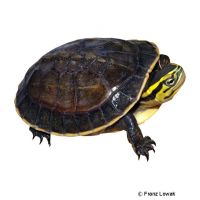Amboina Box Turtle (Cuora amboinensis)
| Amboina Box Turtle Cuora amboinensis | |
|---|---|
| Name | Amboina Box Turtle |
| Name Lat. | Cuora amboinensis |
| Family | Asian River Turtles |
| Family lat. | Geoemydidae |
| Order | Turtles |
| Order lat. | Testudines |
| Origin | Southeast Asia |
| Habitat | Swamps |
| Diet | Fish, crayfish, insects, veggies |
| Humidity | 60-80 % |
| Behavior | ♂ semi-aggressive |
| Keeping | Individual, group |
| Care Level | Moderate |
| Reproduction | Oviparous |
| Housing | Aquaterrarium |
| Life Span | 20 years |
| Protection | CITES Appendix II; EU Annex B |
| Metric Units | |
| Size | 20 cm |
| Temperature | 25-28 °C |
| Temperature Local | 35 °C |
| Housing Size | 100 x 50 x 50 cm |
| US Units | |
| Size | 8" |
| Temperature | 77-82 °F |
| Temperature Local | 95 °F |
| Housing Size | 40" x 20" x 20" |
Distribution and habitat
The Amboina Hinged Turtles are native to eastern India, Thailand, Indonesia and the Philippines. Several subspecies are known in their wide range. They live in slow flowing and stagnant waters such as lakes, swamps, ponds but also rice fields with dense vegetation, which also provides sheltered sunning areas.
Maintenance
Minimum dimensions for the aquaterrarium, according to the size and number of animals
| floor space for 1-2 animals: 4PL x 2PL (L x W) | Water level: 2PB |
The carapace length (PL) and carapace width (PB) is measured on the largest animal. For each additional animal, increase the footprint by 10%, and for the 5th animal and larger, increase the footprint by 20%. An aquaterrarium of e.g. 100 x 50 x 50 cm is recommended, which should be placed in a quiet place
The water part, about two thirds of the base area, should be structured with a soft substrate of fine gravel, with roots, aquatic plants and larger stones (hiding places), some of which reach the water surface. The water depth should not exceed twice the carapace width of the animals. The terrestrial part with a substrate of soft sand-earth mixture should be equipped with robust plants and roots as well as offer sunning places. To maintain water quality, a powerful filter with low flow and frequent water changes are recommended.
| Temp. day: 25-28 °C | Temp. night: 20-25 °C | Temp. local: 35 °C | Water temp.: 24-28 °C |
The lighting duration should be 10-14 hrs. They need daily UV irradiation and sunny places with radiant heat.
Diet
They are omnivores and require a balanced mixture of animal and vegetable food. The food supply consists of commercial water turtle food, supplemented with small crustaceans, snails, earthworms, shrimp, fish pieces, etc., which are also well accepted frozen. In addition, they need vegetable food, such as lettuce, water plants, etc., and occasionally sweet fruit (e.g. banana). Regular addition of minerals and vitamins is important, also cuttlebone should be constantly available. Recommended are at least 1-2 fasting days per week.
A varied diet promotes health and prevents deficiency symptoms.
Reproduction and breeding
Males have a concave ventral carapace and a much thicker tail than females, and the anal opening is closer to the tip of the tail in males
The female lays eggs, often several times a year, 1-4 up to 5 cm in size on the terrestrial part. The incubation period is about 70 days at about 29 °C. The life expectancy can be 20 years.
Species protection
The animal population must be reported in writing to the competent authority immediately after the start of keeping. Subsequently, all arrivals and departures must be reported.
Protection of species: WA II; EU Annex B. The proof of purchase is the required proof of origin for the animal. Please keep it safe! Your pet store will be happy to provide you with further information.
Important
Since the males are very eager to mate, keeping the sexes separately is recommended. Males should be kept singly, females in groups. In case of incompatibility the animals should be separated immediately. For a 6-8 week hibernation period, lower the temperature by 3-5 °C and reduce the lighting time by 2-3 hours.
A transverse joint on the abdominal carapace allows the animals to fold up the anterior and posterior parts in case of danger
The terrarium must have good ventilation without drafts and meet the species specific needs. Measuring devices such as thermometers, hygrometers, etc. are necessary. The lighting has to correspond to the species-specific day-night rhythm and has to be placed in such a way that the animals cannot injure themselves. The terrarium should be locked in such a way that neither unauthorized persons can open it nor the animals can escape. Contamination must be removed regularly
Further literature can be found in your pet store.
References
Text: petdata; Image: Franz Lowak
Source: BMELV (1997): Tierschutzgutachten - Mindestanforderungen an die Haltung von Reptilien; ENGELMANN (2006): Zootierhaltung - Tiere in menschlicher Obhut: Reptilien und Amphibien, Harri Deutsch Verlag; ROGNER (2009): Taschenatlas Schildkröten, Verlag Ulmer
- Gemäß § 21 Abs. 5 Tierschutzgesetz idgF
